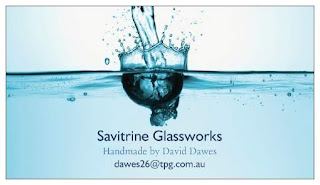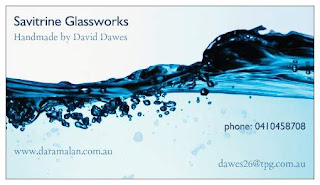Kiln fired or warm glass includes glass fusing, glass slumping into moulds, glass paste (pate de verre) and glass casting. It is not glass blowing (hot glass), lamp or flame working or bead making. It can include cold working like etching, sandblasting and carving.
Glass is an incredible medium to work with – versatile, challenging, unique, surprising and always beautiful. The very history of glass is the stuff of myth and legend. Glass has been used by man for about 5,000 years and the legend recounted by Pliny the Elder (23 – 79 AD) in Natural History is that merchants used nitrum blocks in a fire on a beach at the mouth of the Belo River in the Eastern Mediterranean. The nitrum fused with the sand a liquid glass flowed forth. Nice story but the fire would not have been hot enough and archaeologists have dated glass beads to 3,000 BC, the Bronze Age, in Mesopotamia. The Phoenicians used the glass created in ceramic glazing to decorate pots or as jewellery.
Glass was popular and an item as precious as gemstones. It even gets a mention, as ‘crystal’, in a passage from The Bible, Job 28 12-19.
12 But where can wisdom be found? Where does understanding dwell?
13 No mortal comprehends its worth; it cannot be found in the land of the living.
14 The deep says, “It is not in me”; the sea says, “It is not with me.”
15 It cannot be bought with the finest gold, nor can its price be weighed out in silver.
16 It cannot be bought with the gold of Ophir, with precious onyx or lapis lazuli.
17 Neither gold nor crystal can compare with it, nor can it be had for jewels of gold.
18 Coral and jasper are not worthy of mention; the price of wisdom is beyond rubies.
19 The topaz of Cush cannot compare with it; it cannot be bought with pure gold.
Small glass vessels were produced about 1650 BC, glass mosaic bowls about 1500 BC and glass blowing about 1000 BC. The centres for artisan glass making were Persia, Phoenicia, Syria, Etruria and of course Egypt. As the Roman Empire expanded in the first century BC so did the transfer of glass making knowledge and techniques. As Rome declined the centre for glass shifted to Syria and Palestine where glass blowing reached extraordinary heights. The Mongol invasions destroyed the glass production centres and Venice became the glass capital of the world for over 200 years.
The Venetians transformed glass in the Renaissance and as early as 1271 the glass guild produced strict laws regulating the business protecting secret formulas and techniques and forbidding any glassmaker to work outside of the Republic. In 1291 the glass furnaces were relocated to the island of Murano after frequent fires in the glass district and to prevent foreigners from learning the glassmaker’s skills. In 1457 Angelo Barovier (1405 – 1460) created a perfectly clear, crystalline glass and other makers revived millefiori and mosaic techniques.
By the 16th century Venice had competition from France, Germany and Moravia (Czechoslovakia) and it was not until the late 1950s that Murano again came to the fore. The Germans are credited with the revival of stained glass, specifically a 12th century monk named Theophilus, though coloured ‘glazed windows’ in churches date to the 7th century. Just try to imagine Chartres, Notre Dame or La Sainte Chapelle without their amazing stained glass windows.
An Englishman, George Ravenscroft (1632 – 1683) invented lead crystal glass in 1676 by adding lead oxide to Venetian glass. The practice and art of cutting crystal glass developed from there and England, Ireland and Bohemia became the centres of production.
With industrialisation glass became a utilitarian medium with factories churning out pressed glass pieces for the masses. The English Arts and Crafts and European Art Nouveau movements restored glass to an art form. Emile Galle, the Freres Daum, Henri Cros and Rene Lalique in France and Louis Comfort Tiffany in America created beautiful and functional glass works.
The studio art glass revival began as recently as the 1960s starting a new and exciting era. Glass can be produced in small studios away from industrialisation and is an amazing medium for creative expression. As art and as practical pieces the market is readier than ever for quality products.

























